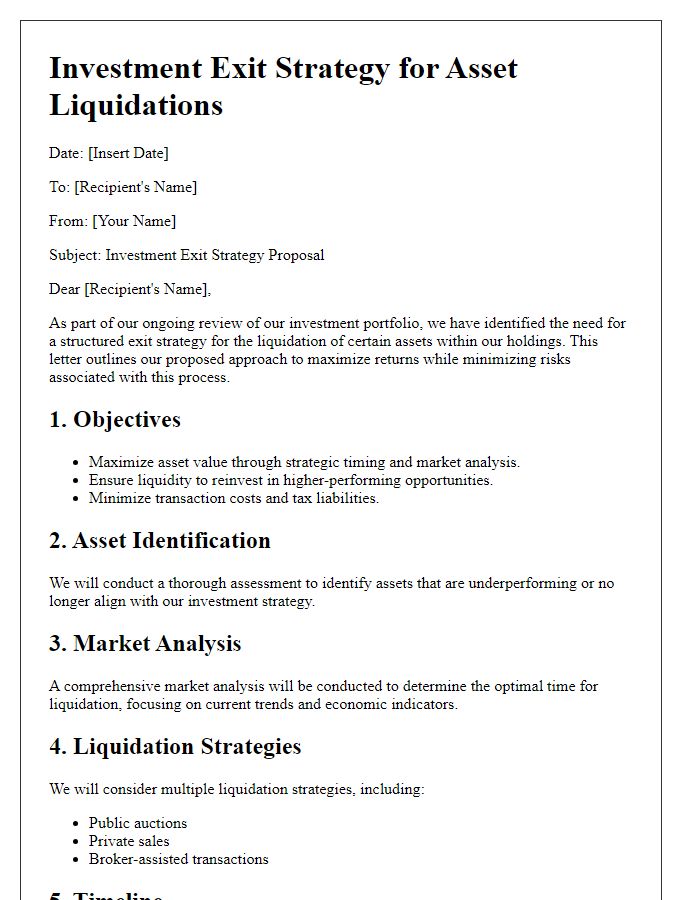Are you looking to maximize your investment returns while minimizing risks? Crafting a well-thought-out exit strategy is crucial to ensure that you can capitalize on your investments when the time is right. In this article, we'll explore key components of an effective exit plan, from market timing to understanding tax implications. So, let's dive in and uncover the essential strategies that can help you secure a profitable exit!

Clear Identification of Parties
An investment exit strategy outlines the specific methods and timelines for asset liquidation, guiding interested stakeholders such as investors, investment managers, and company owners. Clear identification of parties involved, such as shareholding entities or partnership firms, is crucial for understanding roles and responsibilities during the exit process. For example, understanding the legal entity--whether a Limited Liability Company (LLC) based in Delaware or a publicly traded corporation on the NASDAQ--can impact the exit route, such as Initial Public Offerings (IPOs) or mergers and acquisitions (M&A). Defining the stakeholders, including minority shareholders holding 20% of shares or venture capital firms with substantial equity stakes, ensures transparency and accountability throughout the exit phase. Detailed provisions regarding notices, voting rights, and distribution of proceeds must also be established, securing a structured approach to investment liquidation.
Detailed Exit Timeline
A well-defined exit strategy is crucial for investors seeking to maximize returns on investments over time. The exit timeline typically includes phases such as initial investment assessment, market analysis, growth milestones, and eventual exit execution. For instance, in a startup ecosystem, initial due diligence may last approximately three months, followed by a one-year growth phase focusing on revenue targets and user acquisition strategies. After achieving these milestones, potential exit options, such as acquisition discussions or Initial Public Offerings (IPOs), may commence approximately twelve to eighteen months later. Throughout this process, it is essential to evaluate market conditions, competitive landscape, and investor sentiment, which can all influence the timing and method of exit. Finally, an effective exit can be finalized through negotiations, ideally resulting in a lucrative return on investment, which might typically range from 3x to 10x the original capital invested, contingent upon the success of the venture.
Financial Settlement Terms
A well-structured financial settlement strategy is crucial for an effective investment exit, ensuring clarity and mutual understanding between stakeholders. Clear valuation methods, including Discounted Cash Flow (DCF) analysis, should determine the exit value based on project forecasts and anticipated market conditions. The choice of a liquidity event, such as an Initial Public Offering (IPO) or acquisition, plays a pivotal role in maximizing returns, influenced by market trends typical in sectors like technology or healthcare. Establishing precise timelines for the exit ensures all parties remain aligned towards an agreed-upon schedule, often ranging from three to five years post-investment. Incorporating clauses related to tax implications and legal considerations safeguards against unexpected costs, impacting overall profitability. Regular updates and transparent communication with all stakeholders throughout the investment cycle can mitigate disputes and streamline the exit process, ultimately resulting in a smoother financial settlement.
Confidentiality Clauses
Confidentiality clauses in an investment exit strategy are critical legal provisions that protect sensitive information from being disclosed to unauthorized parties. Often included in investment agreements, these clauses outline the obligations of all parties involved, ensuring that proprietary information--such as financial data, trade secrets, business plans, and client lists--remains confidential during and after the exit process. Typically, these clauses specify the duration of confidentiality obligations, which may extend beyond the termination of the agreement, and detail permissible disclosures to certain parties, such as legal advisors or potential buyers under similar confidentiality obligations. Failure to adhere to these clauses could result in significant legal repercussions and financial loss, affecting the strategic alignment and reputation of the involved entities.
Legal Compliance and Obligations
Investment exit strategies require a thorough understanding of legal compliance and obligations essential for safeguarding investor interests. Regulatory frameworks such as the Securities Exchange Act of 1934 govern the sale and transfer of securities, ensuring transparent practices. Documentation, including exit agreements, must adhere to state laws (typically varying by jurisdiction) to avoid legal missteps. Additionally, due diligence is crucial, particularly regarding contractual obligations of involved parties, which can lead to potential liabilities if not properly managed. Compliance with tax implications, including capital gains tax assessments, further plays a crucial role in optimizing exit outcomes while ensuring adherence to statutory requirements set forth by entities like the Internal Revenue Service (IRS) in the United States. Legal counsel often becomes a pivotal resource in navigating these complexities, ensuring all procedures align with current regulations, thereby protecting all stakeholders during the exit process.
Letter Template For Investment Exit Strategy Samples
Letter template of investment exit strategy for private equity investors

Letter template of investment exit strategy for mergers and acquisitions












Comments